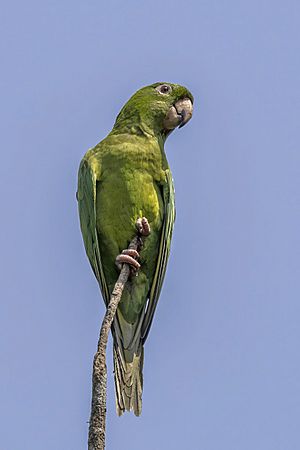Pacific parakeet facts for kids
Quick facts for kids Pacific parakeet |
|
|---|---|
 |
|
| Suchitepéquez Department, Guatemala | |
| Conservation status | |
| Scientific classification | |
| Genus: |
Psittacara
|
| Species: |
strenuus
|
 |
|
| Synonyms | |
|
P. holochlorus strenuus |
|
The Pacific parakeet (Psittacara strenuus), known as Pacific conure or Nicaraguan green conure in aviculture, is a species of bird in subfamily Arinae of the family Psittacidae, the African and New World parrots. It is found in southern Mexico, Guatemala, El Salvador, Honduras, and Nicaragua.
Contents
Taxonomy and systematics
The Pacific parakeet was for a time placed in the genus Aratinga but from about 2013 has been in its present genus Psittacara. Its taxonomy is otherwise unsettled. The International Ornithological Committee, the American Ornithological Society, and the Clements taxonomy treat it as a full, monotypic, species. BirdLife International's Handbook of the Birds of the World (HBW) considers it to be a subspecies of the green parakeet (P. holochlorus).
Description
The Pacific parakeet is about 32 cm (13 in) long. The sexes are alike. Adults are generally olive green that is slightly yellowish on the underparts; some have red speckles on their neck. The undersides of their flight feathers and tail are olive-yellow. Their iris is orange-red surrounded by bare pale beige skin, their bill horn colored, and their legs and feet brownish.
Distribution and habitat
The Pacific parakeet is found on the Pacific slope from southern Mexico's Oaxaca state south through Guatemala, El Salvador, and Honduras into central Nicaragua. It inhabits a variety of woodland landscapes including deciduous, semi-deciduous, and evergreen; gallery forest; swamp forest; and arid scrublands. It also occurs in upland pine-oak forest and in urban parks and gardens. In elevation it ranges from sea level to 2,600 m (8,500 ft).
Behavior
Movement
The Pacific parakeet is non-migratory but makes local movements in response to food availability.
Feeding
The Pacific parakeet's diet has not been fully documented but is known to include seed and fruits. It can be a crop pest. Flocks may exceed 100 individuals.
Breeding
The Pacific parakeet's breeding biology is not well known. It has been documented nesting in rock crevices and cavities in earthen banks; it probably also nests in cavities in trees and termitaria. Its breeding season appears to include June to September.
Vocalization
The Pacific parakeet's flight call is rendered as "kreh!-kreh!-kreh!-kreh!...". Its perched call is lower pitched, "a scratchy kreeh-kreeh-kreeh-kreei-kreei".
Status
The IUCN follows HBW taxonomy and so includes the Pacific parakeet in its assessement of the green parakeet as being of Least Concern. It has estimated that the combined population numbers about 200,000 mature individuals and is decreasing. No immediate threats have been identified. It is thought to be fairly numerous in parts of its range and occurs in at least two protected areas.
See also
 In Spanish: Psittacara strenuus para niños
In Spanish: Psittacara strenuus para niños




